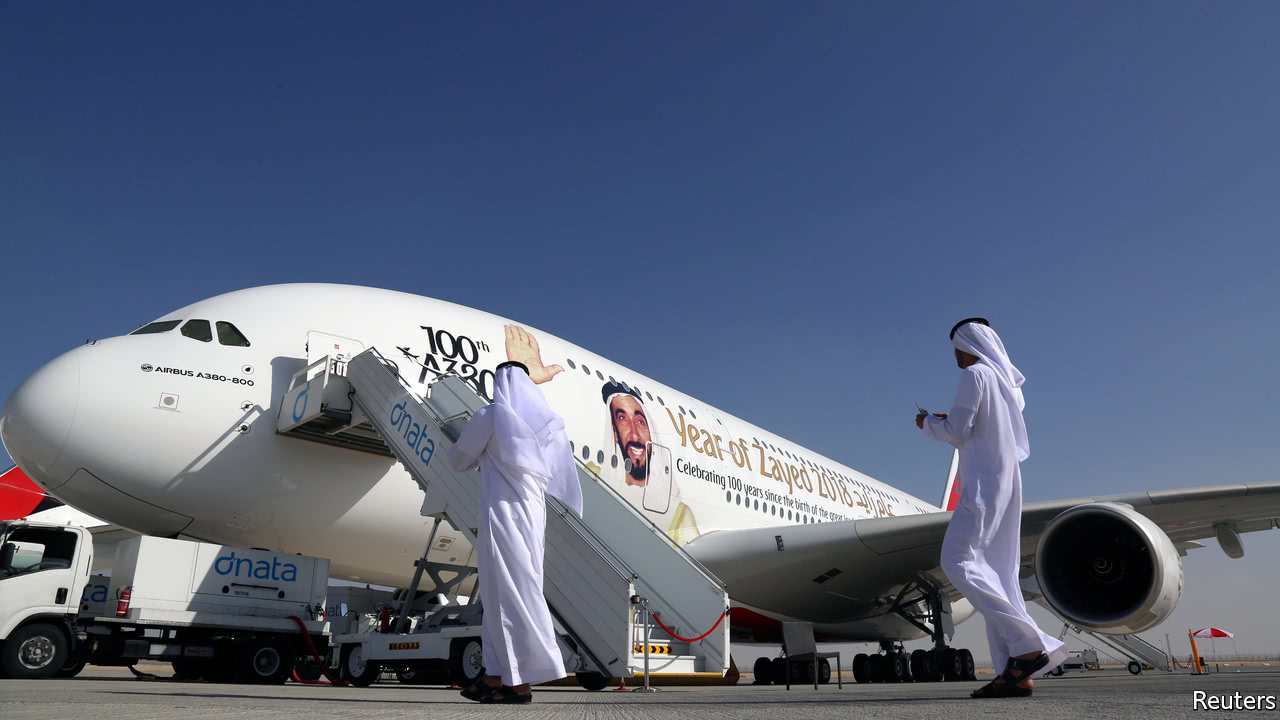
ASK frequent flyers which is their favourite aircraft and most come up with the same answer: the A380 superjumbo made by Airbus, a giant European planemaker. Able to carry 525 passengers in a typical three-class layout, on two full-length decks, the aircraft still feels spacious, with wide aisles and plenty of headroom. Frequent flyers also admire the freshness of the cabin air, the lighting systems that are designed to reduce jet lag and the quietness of the cabin. “You can hardly hear it take off,” one fan recently told Gulliver. “And I can actually go to sleep on the plane unlike any other I’ve been on before.”
-
What is happening to Africa’s pirates?
-
Chris Christie’s eight tumultuous years as governor of New Jersey
-
The days of the A380 look numbered
-
The Supreme Court takes on two redistricting cases from Texas
-
All the president’s tweets
-
Carillion’s collapse raises questions about pension protection
But less than a decade after it carried its first paying passengers, the age of the superjumbo looks like coming to an end. When Airbus announced its plans to build the plane in 2000, it hoped to sell up to 1,200 of them over two decades. Eighteen years later it has sold just a quarter of that figure, and has received no orders for three years. Running short of orders, on January 15th Airbus’s chief salesman said in response to a question posed by Gulliver that if the company does not receive another big order for the planes, superjumbo production may come to an end. “If we can’t work out a deal with Emirates, there is no choice but to shut down the programme,” John Leahy said.
Even though frequent flyers love the plane, airlines are more ambivalent. For most it is simply too much aircraft. Carriers have found that on routes such as London to New York, it is more profitable to operate a greater number of daily departures with smaller jets than to agglomerate traffic onto the A380—however nice its creature comforts.
The exception is Emirates, a carrier based in Dubai that now operates over 100 of the jets (around half of all those ever produced). It has made the superjumbo a key part of its brand, equipping them with innovative features such as a cabin ceiling that lights up with LEDs like a night sky and onboard showers in first class. Airbus was hoping that the president of Emirates, Sir Tim Clark, would save the A380 programme by ordering another 36 or so of them at the Dubai Air Show last November. But in a humiliating spectacle, Emirates pulled out the deal and ordered 40 Boeing 787-10 airliners made by its American arch-rival.
Sir Tim told Gulliver that the deal came unstuck over getting Airbus to commit to producing the A380 jet for another ten years. Without such a guarantee, Airbus could end production sooner, causing the resale value of all existing A380s to plummet. With demand for its flights via Dubai reduced due to lower oil prices and regional instability, Emirates has to be particularly careful when ordering aircraft. Its shareholder—the government of Dubai—sees the airline as a cash cow now that falling oil prices have hit state revenues. The government provided $10m in start-up capital in 1985, Sir Tim says, and nothing more since. Instead they have taken out $4bn in dividends. They do not want to invest any more in the airline and want the stream of profits to continue, something that would be put in doubt if Emirates buys too many superjumbos at too high a price.
Emirates clearly wants to get a better price out of Airbus for the planes. But Airbus knows that the A380’s association with the Gulf carrier’s brand is so strong that any announcement to end production would damage both companies. That may be why Mr Leahy is threatening to pull the plug on the programme: to hold Emirates’ feet to the fire. He is thought to be keen to secure a final deal for the planes before he retires after next month’s Singapore Air Show.
Although it has contingency plans to stop production if Emirates does not place another order, Airbus still holds out hopes that they will not need activation. It hopes to sell more of the jets to China, whose airports and air space are becoming increasingly congested as the middle classes take to the sky. Earlier this month Airbus offered to make parts of the A380 in China if the country’s airlines made an order for the planes—a tried-and-tested way that aircraft manufacturers use to gain attention there. With an order from Emirates and the Chinese, it could continue production at a slow rate into the 2030s, by which time congestion at the world’s hub airports will have got so bad that the investment case for a bigger and more fuel efficient update to the A380 should be commercially viable. As Mr Leahy notes, passenger numbers are set to double every 15 years, whereas airport expansion is likely to proceed at a snail’s pace. The superjumbo may be down. But Airbus, Emirates and frequent flyers alike all have good reason to hope that it is not yet quite out.
Source: economist
The days of the A380 look numbered